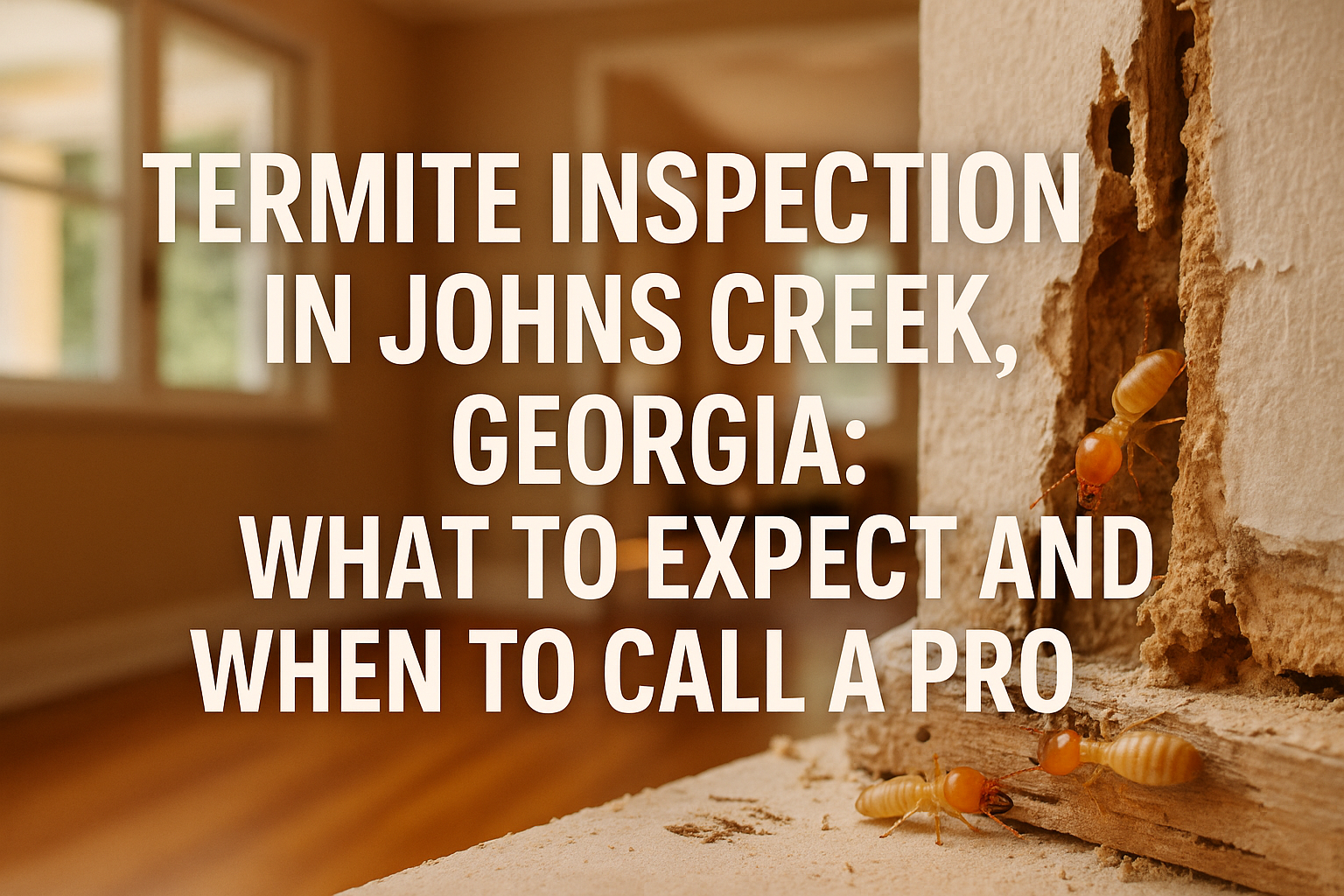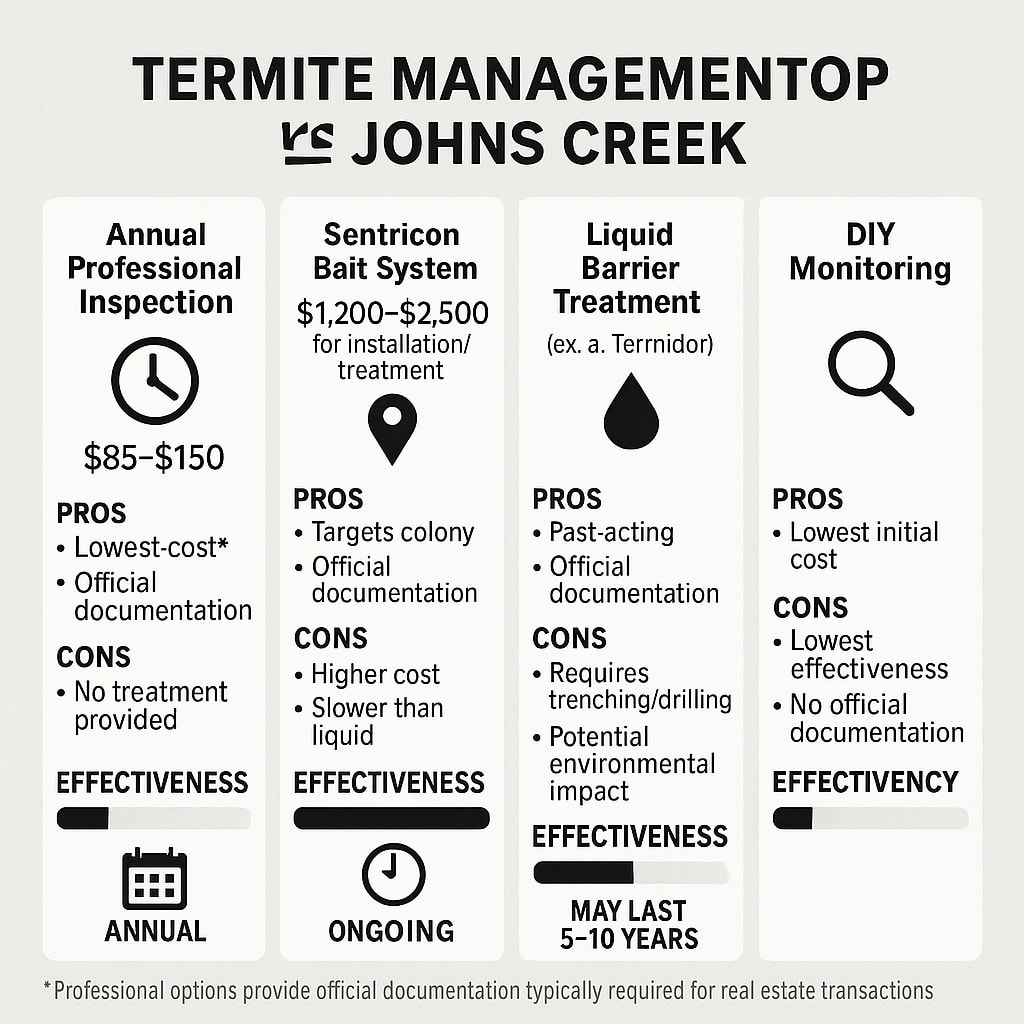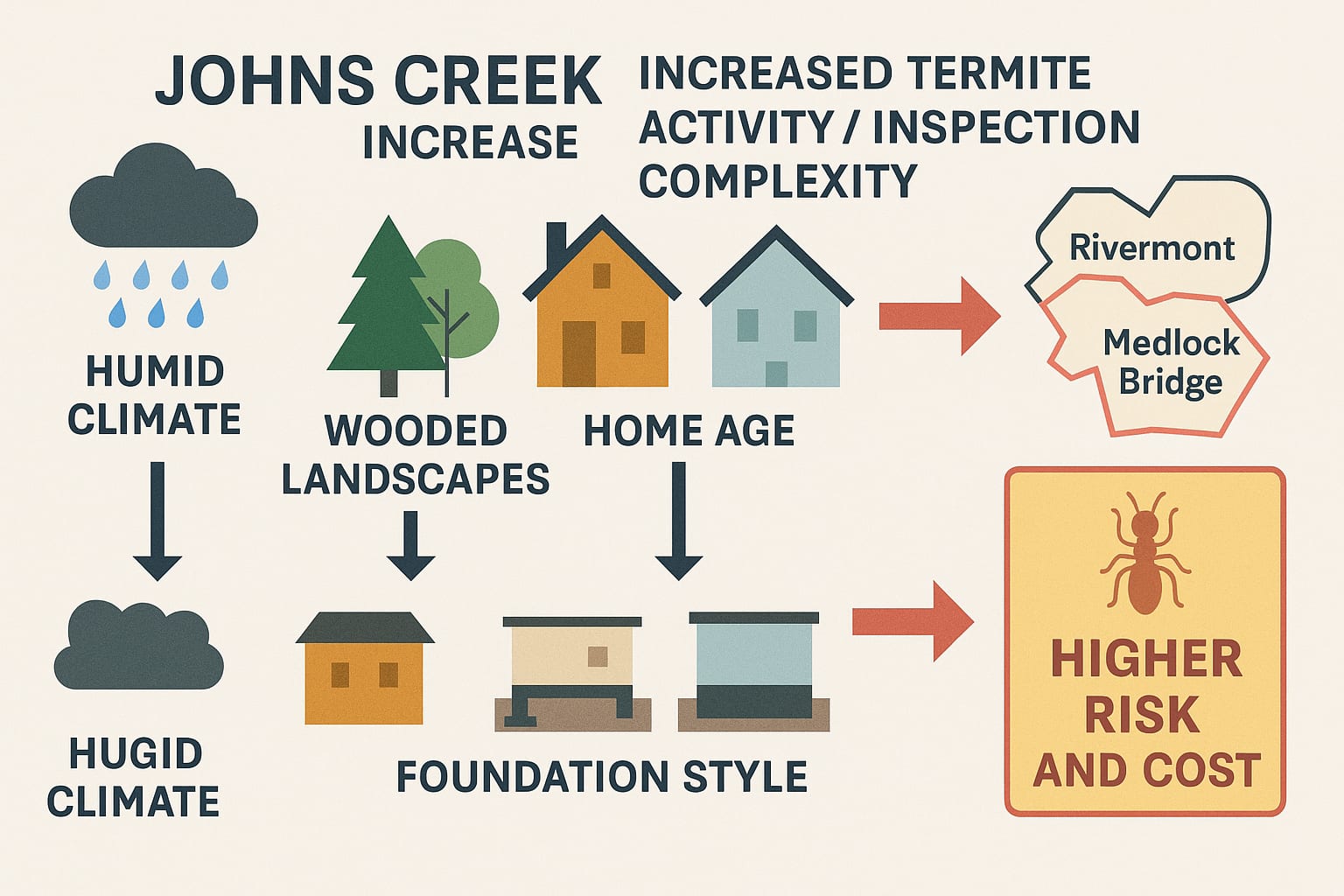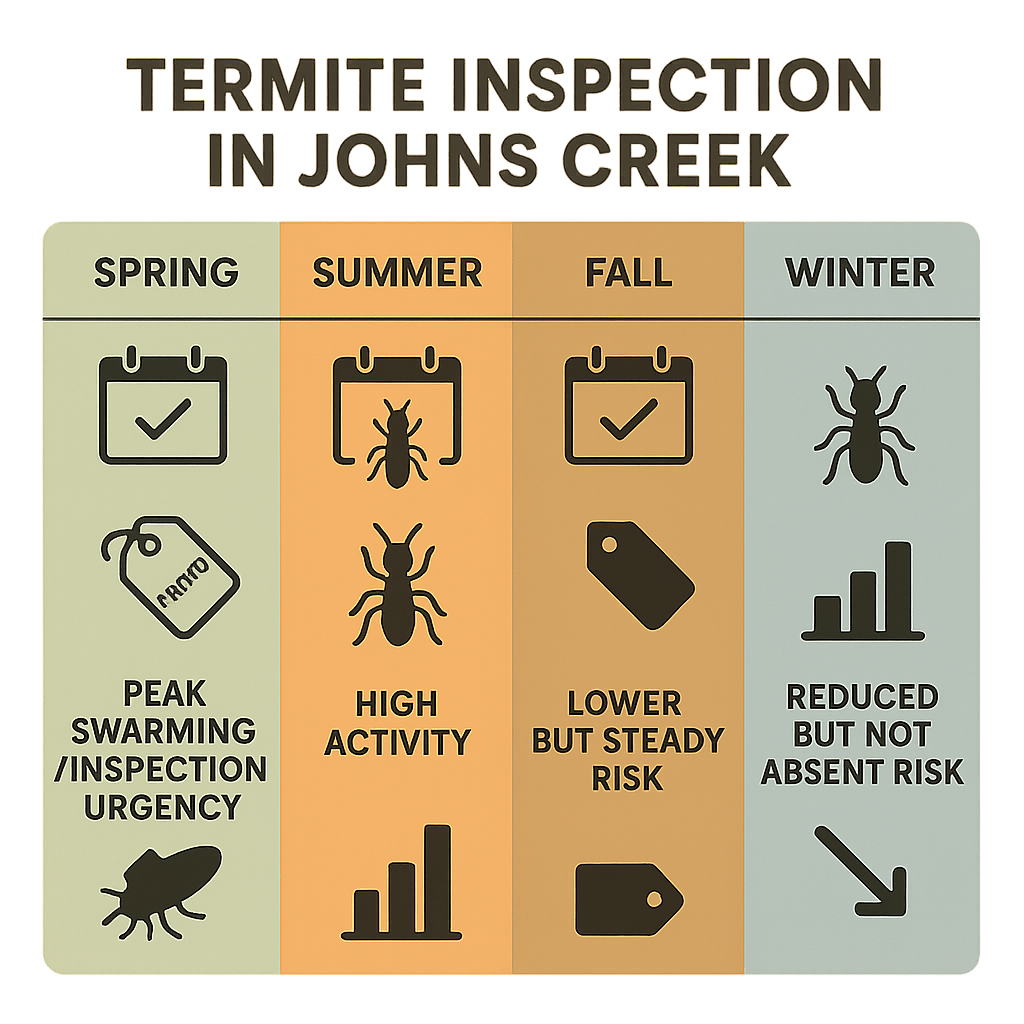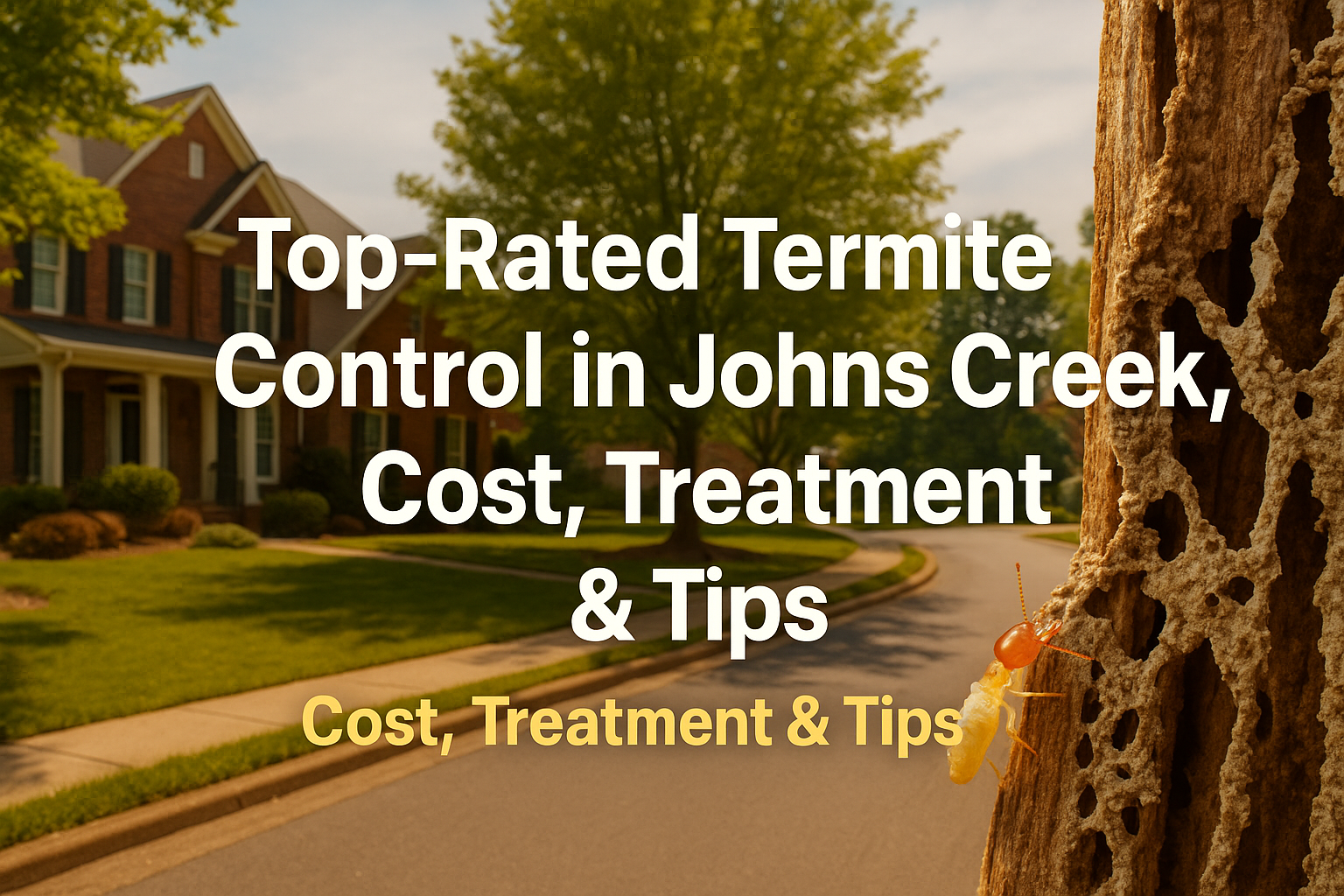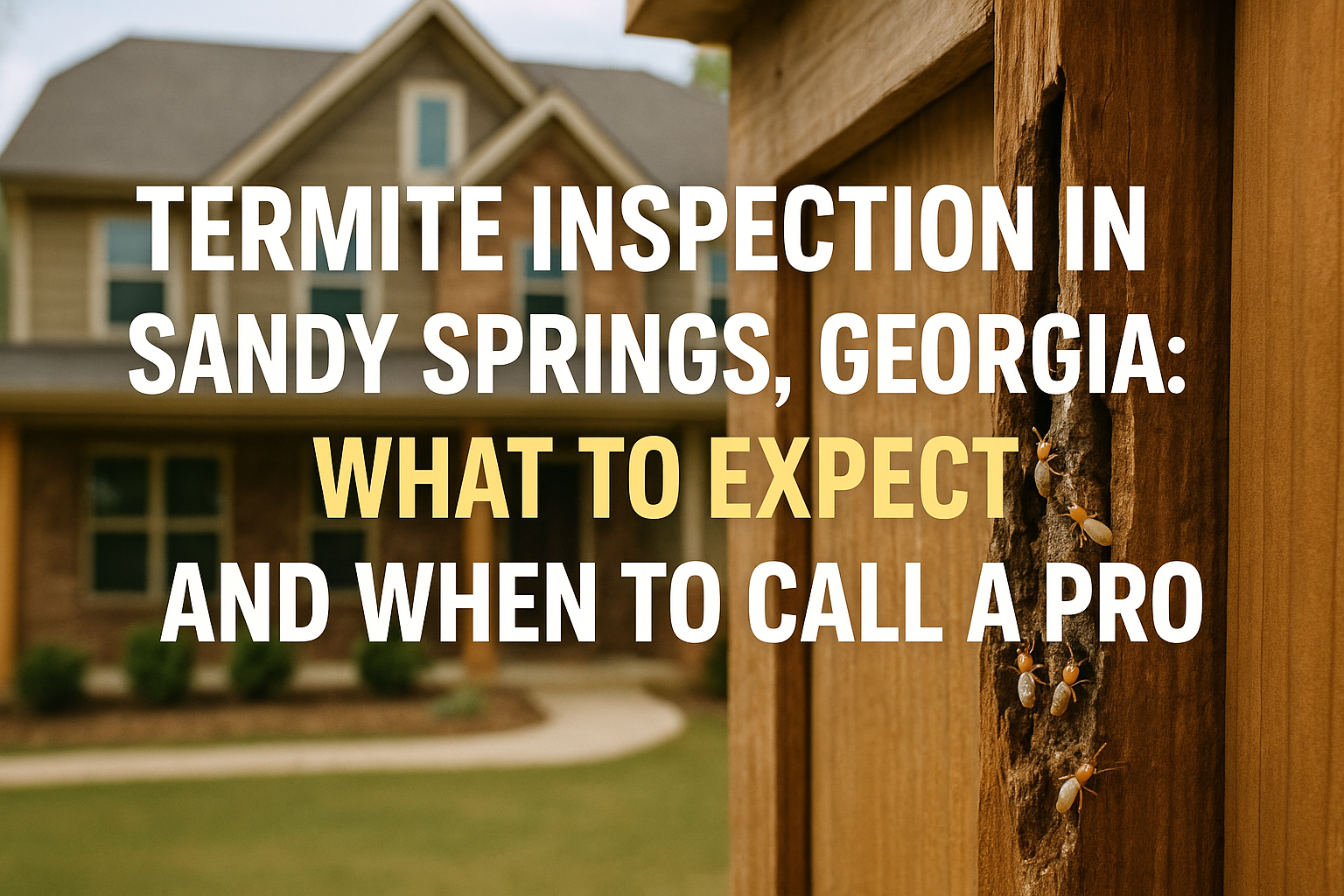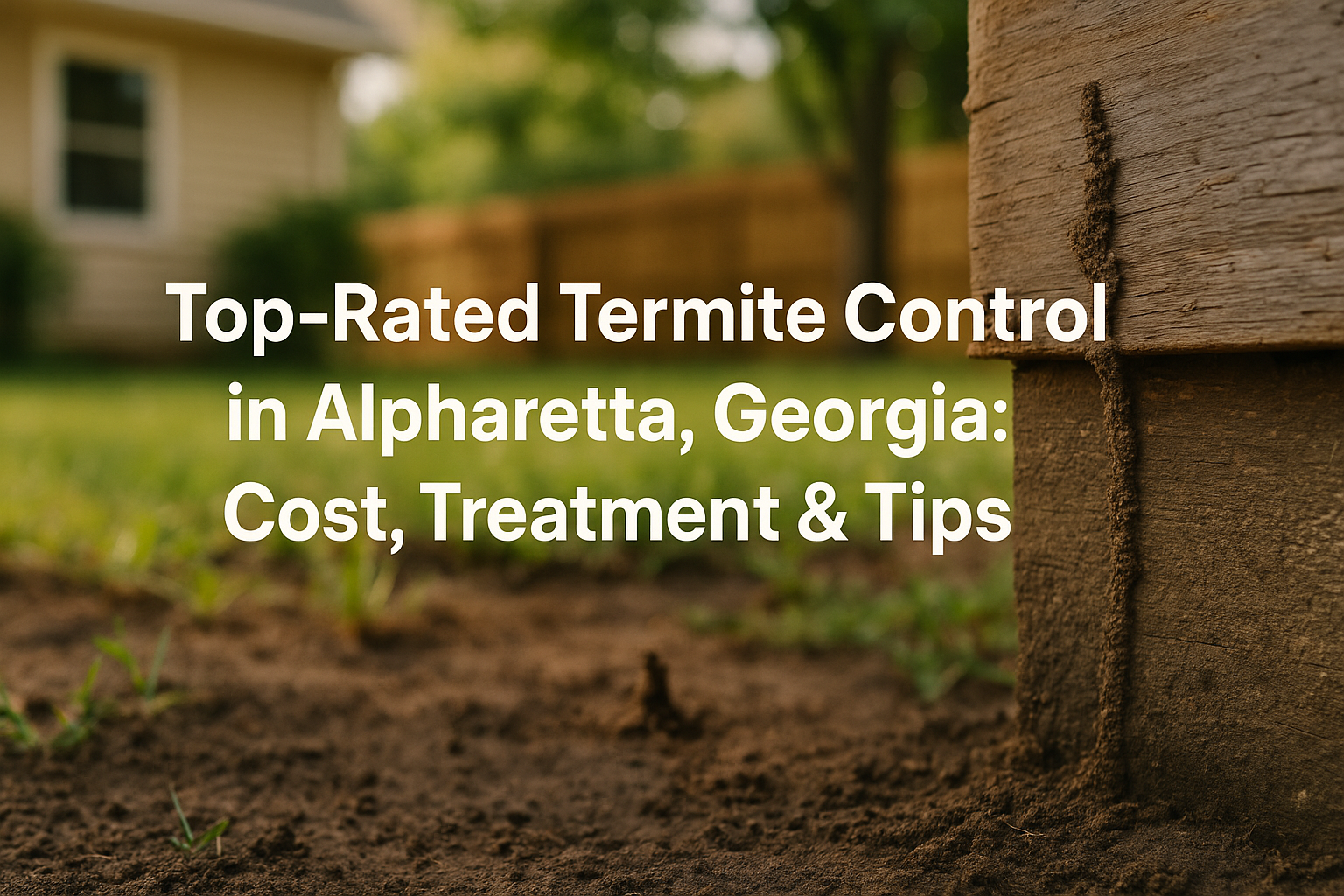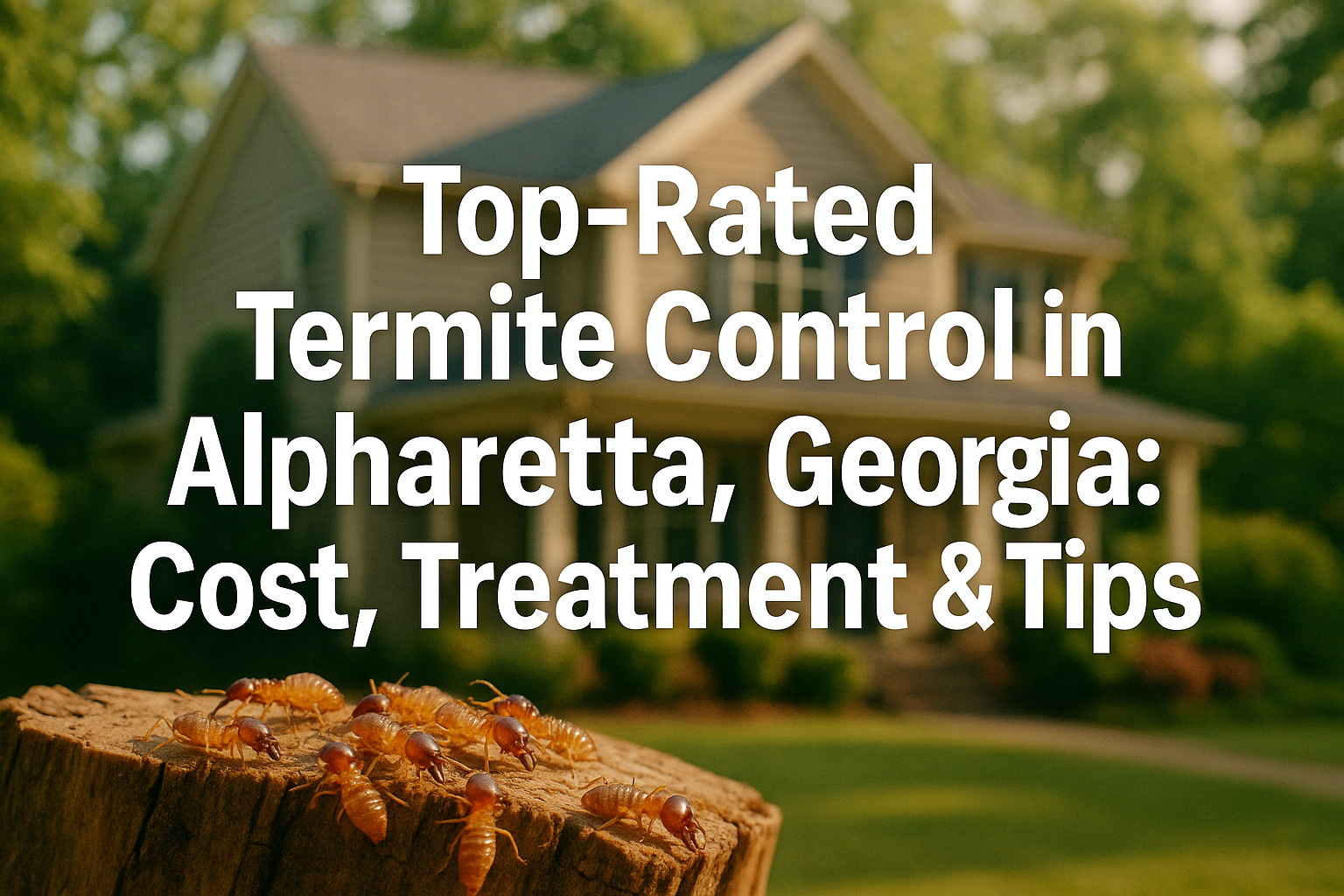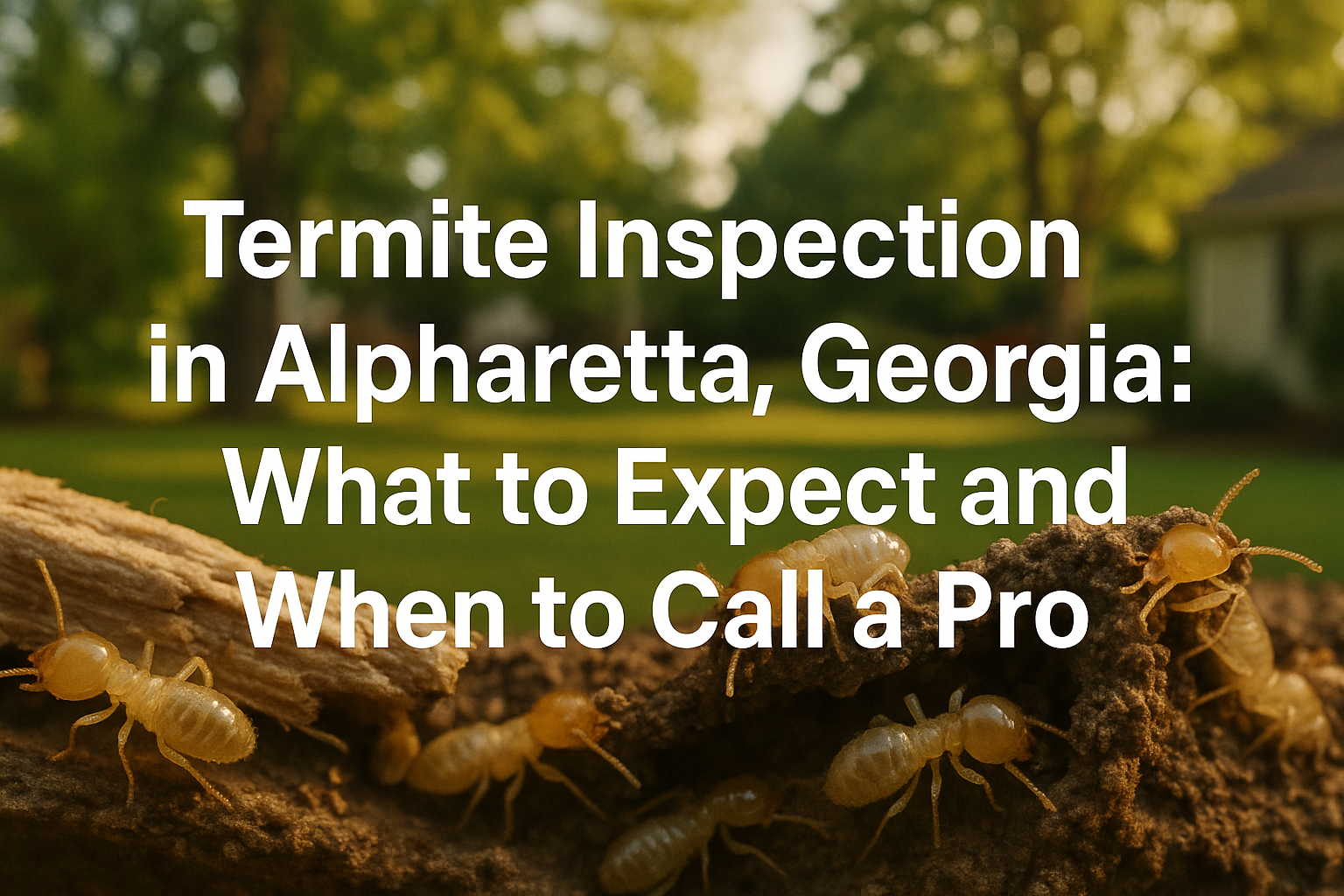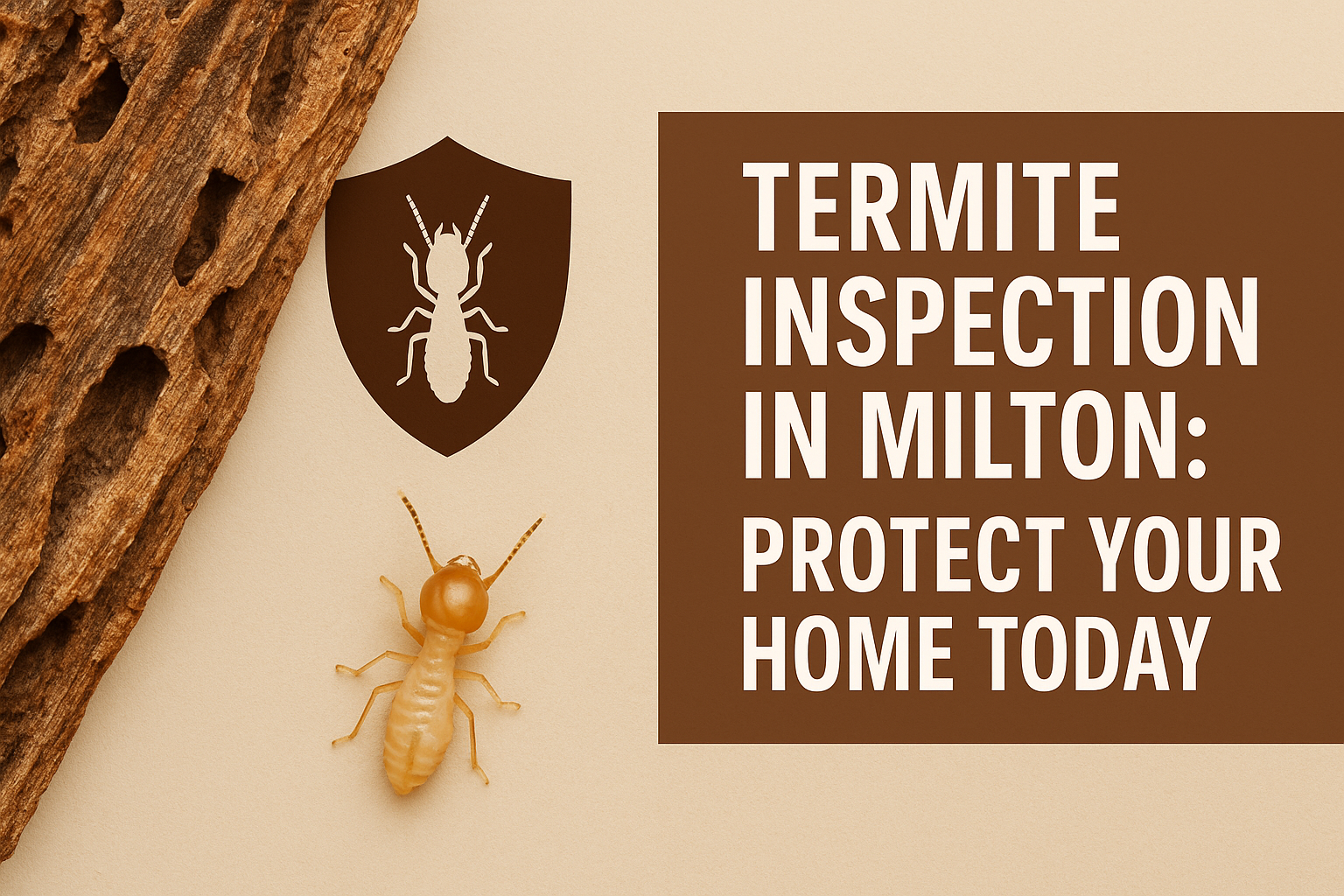Why Termite Inspections Matter for Johns Creek Homeowners
If you own a home in Johns Creek, scheduling a termite inspection Johns Creek professionals recommend is one of the smartest ways to protect your property and termites should be near the top of that list. Our Georgia humidity isn’t just annoying for us, it’s like a welcome mat for termites. These pests love the damp, warm conditions and, if we’re not careful, they can quietly chew through wood, drywall, floors, and even furniture long before you see a single sign of damage.
No neighborhood is immune. Folks in Medlock Bridge, Sugar Mill, Rivermont, or Abberley Towneship all face the same hidden threat. In fact, houses with crawl spaces, older properties, and homes with a lot of wood are especially vulnerable. The truth is, even well-built homes can become targets without warning. One small colony, left unchecked, can cause thousands of dollars in repairs before you ever hear a peep.
A professional termite inspection in Johns Creek usually runs between $85 and $150—money well spent when you consider what’s at stake. Need treatment? That can jump to anywhere from $800 up to $2,500, depending on how bad the problem is and how big your property is. Catching termites early with regular inspections is key to saving your foundation, your peace of mind, and your wallet.
So, if you’re a homeowner who wants to avoid expensive surprises, it’s smart to know what to expect from an inspection, how the costs break down, and what you can do to guard your property. This article has you covered—we’ll break it all down, from the price of inspections to the best prevention game plan. If you want to keep your home safe from costly termite surprises, now’s the time to pay attention to your options.
What Impacts the Price of Termite Inspection and Treatment in Johns Creek?
If you’re wondering why termite inspections and treatments in Johns Creek come with such a wide range of prices, you’re not alone. There’s no one-size-fits-all answer because a handful of factors really shape what you’ll pay—whether it’s for a routine check-up or a bigger fight against these pesky invaders.
First off, think about your home itself. A smaller townhouse in Abberley Towneship might be a quick inspect-and-go, but if you’ve got a large, winding home in Sugar Mill or a property with a finished basement and crawlspace, expect a more in-depth process. Bigger homes take longer to inspect and can have more risk points, which means those inspections usually cost a bit more.
The next thing is the infestation itself. If we’re talking about a minor problem—maybe you caught it early—that’s usually easier (and cheaper) to fix with targeted treatments. But if termites have had time to spread and settle in, now you’re looking at comprehensive treatment plans, sometimes with repeat visits and long-term monitoring. Naturally, that raises the cost.
Treatment method plays a big role, too. Some folks opt for bait systems like Sentricon while others go for liquid barrier treatments. Bait systems are popular because they work quietly over time, but they carry different upfront and maintenance costs compared to traditional liquid solutions. Part of what we do is help you weigh the pros and cons for your specific situation and property.
Location and neighborhood style shouldn’t be overlooked, either. Older homes or properties in heavily wooded parts of Johns Creek are generally at higher risk for termites, so you might need a more vigilant inspection schedule or beefier preventive options.
Just to give you a ballpark: most annual inspections around Johns Creek will fall between $85 and $150. But if your inspector finds live termites or clear damage, the bill for full-service treatment jumps—expect anywhere from $800 up to $2,500 depending on how tough the job turns out to be and what treatment option you choose.
At the end of the day, the best approach is to get an honest, on-site evaluation from a local termite expert. That way, you’ll know exactly what’s going on and what you’re paying for—no guessing games, just real answers for your home and your peace of mind.
What Impacts the Price of Termite Inspection and Treatment in Johns Creek?
If you’re wondering why termite inspections and treatments in Johns Creek come with such a wide range of prices, you’re not alone. There’s no one-size-fits-all answer because a handful of factors really shape what you’ll pay—whether it’s for a routine check-up or a bigger fight against these pesky invaders.
First off, think about your home itself. A smaller townhouse in Abberley Towneship might be a quick inspect-and-go, but if you’ve got a large, winding home in Sugar Mill or a property with a finished basement and crawlspace, expect a more in-depth process. Bigger homes take longer to inspect and can have more risk points, which means those inspections usually cost a bit more.
The next thing is the infestation itself. If we’re talking about a minor problem—maybe you caught it early—that’s usually easier (and cheaper) to fix with targeted treatments. But if termites have had time to spread and settle in, now you’re looking at comprehensive treatment plans, sometimes with repeat visits and long-term monitoring. Naturally, that raises the cost.
Treatment method plays a big role, too. Some folks opt for bait systems like Sentricon while others go for liquid barrier treatments. Bait systems are popular because they work quietly over time, but they carry different upfront and maintenance costs compared to traditional liquid solutions. Part of what we do is help you weigh the pros and cons for your specific situation and property.
Location and neighborhood style shouldn’t be overlooked, either. Older homes or properties in heavily wooded parts of Johns Creek are generally at higher risk for termites, so you might need a more vigilant inspection schedule or beefier preventive options.
Just to give you a ballpark: most annual inspections around Johns Creek will fall between $85 and $150. But if your inspector finds live termites or clear damage, the bill for full-service treatment jumps—expect anywhere from $800 up to $2,500 depending on how tough the job turns out to be and what treatment option you choose.
At the end of the day, the best approach is to get an honest, on-site evaluation from a local termite expert. That way, you’ll know exactly what’s going on and what you’re paying for—no guessing games, just real answers for your home and your peace of mind.
Johns Creek’s Climate and Home Styles: Why Termites Love It Here
If you’ve lived in Johns Creek for long, you know our summers are hot and humid, and winters never really hit that bone-chilling deep freeze. Turns out, that’s the perfect recipe for termites to thrive. These bugs don’t need a break—they keep looking for their next meal (usually in the form of your home) just about every month of the year. That means keeping an eye out for them is a full-time job, not just something you do before selling or buying.
- Wood-Framed Homes: Most houses around here use traditional wood framing. If your place has crawl spaces, basements, or an older slab foundation, it’s even more appealing to termites — think of it as an all-you-can-eat buffet for these critters.
- Lush Landscaping: All those pretty shrubs and trees close to the foundation? Beautiful, but they keep soil moist and shaded—which termites love. Moisture is their comfort zone, especially after our classic Georgia rainstorms.
- Neighborhood Hotspots: If you’re near wooded patches like those in Rivermont or Medlock Bridge, you’re under even more pressure. Termites naturally migrate in from these forests, looking for easier meals as local ecosystems shift through the seasons.
- Newer Construction: We’re seeing more steel frames and poured concrete in the area’s newer homes. They’re a bit more termite-resistant, but not completely safe—termites sneak through cracks or build mud tubes over concrete when they’re determined.
Mild winters mean termite colonies don’t really slow down, so waiting until “peak” season isn’t enough. Add in all that rain—especially during spring and late summer—and the soil around your place can become termite paradise overnight. That’s why inspections here aren’t a once-a-year thing for most folks. If you’ve got wood framing, lots of landscaping, or an older home, twice-a-year checks make a lot of sense.
Ultimately, your neighborhood’s tree cover, local rainfall, and the way your home was built all play a big part in how often you need to check for termites and what it’ll take to defend your property. Understanding these local factors is the first step in making the right call on inspections and treatment down the road.
Simple Steps to Keep Termites – and Extra Costs – Out of Your Johns Creek Home
Let’s face it: nobody wants to deal with termites or expensive repairs. But a little prevention goes a long way to save you headaches down the road. In Johns Creek, where mature trees and moisture are common, here’s what you can do right now to cut your risk and keep more money in your pocket.
- Keep an eye on water. Don’t let water collect close to your foundation – termites love damp soil. Clean out your gutters and downspouts on a regular basis so rainwater flows away, not toward your house. Fix any plumbing drips, leaky AC units, or standing puddles near your foundation ASAP.
- Clear the border. Make sure soil, mulch, firewood, or lumber are at least a few inches away from exterior walls. Anything touching your siding acts like a welcome mat for termites looking for a snack.
- Ventilate crawl spaces. If your home has a crawl space, see that it’s dry and well-ventilated. Set up vapor barriers to block ground moisture and check that vents aren’t covered by plants or debris.
- Give your home some space. Bushes and trees might look great up close, but overgrown plants trap moisture and hide early warning signs. Trim back shrubs and branches – especially if your home backs up to a wooded lot.
- Invest in annual checkups. Getting a professional termite inspection once a year doesn’t just give peace of mind – it could save you thousands by catching problems early, before real damage happens. This is especially important if your home is older, has just been remodeled, or is in an area with known termite activity.
Here’s the bottom line: the moment you spot mud tubes, discarded wings on windowsills, or suspicious wood damage, don’t ignore it. Calling in pros right away almost always means simpler, less expensive treatments. The sooner you act, the less you’ll spend on repairs and mitigation.
Up next, we’ll give you a simple, must-have checklist to help you stay on top of termite prevention all year long in Johns Creek.
Why Timing Your Termite Inspection Matters in Johns Creek
If you’ve called Johns Creek home for a while, you know just how unpredictable Georgia’s seasons can be—and so are the termites. When it comes to keeping your property safe, the season you schedule your termite inspection really does matter.
Spring is when the drama unfolds. Termites start swarming everywhere from March through June, meaning this is prime time to catch them in the act. Inspections during spring aren’t just about luck—they’re about smart timing. Catching an infestation early gives you more options, and pros are best equipped to spot issues when swarmers are at their most active. But be warned: everyone else wants inspections right now, too. Demand is high, so booking early secures your spot and the standard rates. Wait too long and you might end up with pricier emergency visits, or even a full-blown treatment job to deal with.
Summer doesn’t mean termites pack up and leave. Colonies are out there growing and eating, just not as dramatically. A summer inspection can still spot recent activity, so you’re not letting anything slip by until next spring.
Come fall, things slow down above ground and that’s actually a great time for a check-up. Inspectors are less swamped, you might catch a deal, and you’ll have peace of mind before winter hits. If you’re thinking about selling or refinancing your home, this is also a smart window for a preventative inspection.
Think you’re safe in winter? Not quite. Subterranean termites don’t care about chilly air; they hunker down and stay active beneath the soil, especially during mild winters like we often get here. That’s why annual termite checks are a year-round must in Johns Creek—skipping even one season leaves a door open for trouble.
- Pro tip: Get ahead of the curve. Schedule inspections before swarm season or property transactions, and you’ll save yourself both time and money. In pest control, local know-how and timing are everything.
Ready to plan smart? Check out the next section for a handy breakdown of seasonal pros and cons, so you’ll always know when to get ahead of the termites.
Don’t Wait – Protect Your Home from Termites Today
If you’re even a little concerned about termites, now’s the time to take action. At Anthem Pest Control, we make it easy for Johns Creek homeowners to get the answers you need. Our pros are local, fully licensed, and genuinely care about keeping your property safe. With a free, no-obligation inspection, you have nothing to lose – and peace of mind to gain.
We’ll come out, check for any signs of termite activity, document exactly what we find, and walk you through smart solutions tailored for your home and neighborhood. No high-pressure sales, just honest advice from people who know what they’re doing.
Let us help you stay ahead of termites—before they can do their worst. Pick up the phone and call us now at 877-3718-5196 or get your free quote online here. Your home deserves the best protection, and so do you.
Answers to Common Termite Questions for Johns Creek Homeowners
Termite worries? You’re not alone! Here are clear answers to the questions Johns Creek homeowners ask us most:
- How often should I get my home checked?
If you own property here in Johns Creek, a professional termite inspection once a year is smart. Got an older home, or live in a spot that’s had trouble in the past? You might want to play it safe with twice a year. - Can I handle inspections by myself?
You can look for evidence like mud tubes or wings, but—honestly—nothing beats a trained eye. Plus, if you need official paperwork (like if you’re selling your place), you need a pro to do it right. - What signs should I watch for?
Keep your eyes peeled for mud tubes on foundation walls, piles of discarded wings near windows, hollow-sounding wood, and visible damage. These are your biggest red flags that termites might be hungry. - Are termites in Georgia a year-round headache?
Absolutely. Subterranean termites in our area don’t really take a break, especially with our mild winters. Activity peaks in spring and summer—prime time to be alert—but don’t think you’re in the clear the rest of the year. - What happens during a professional inspection?
We check every nook and cranny we can access—from crawl spaces to attics. You’ll get a written report, and if we spot trouble, we’ll lay out your treatment options. - What does treatment cost around here?
Depending on what we find and what needs to be done, expect to pay anywhere from $800 to $2,500 for termite treatment. Fast action usually keeps costs on the lower side. - Do you take care of all Johns Creek neighborhoods?
Yes—Medlock Bridge, Abberley Towneship, Sugar Mill, and every corner of Johns Creek. If you’re here, we’ve got you covered. - Does insurance pick up the tab for termite damage?
Sorry, but no; most homeowners insurance won’t cover termite repairs. That’s why inspections matter so much—they help you dodge big bills down the road.
If you’re ever unsure or just want a little peace of mind, we’re just a call away. Protecting Johns Creek homes from termites is what we do, and we do it well.

